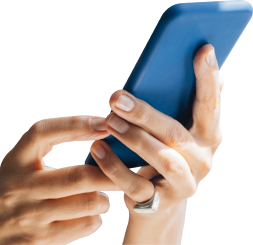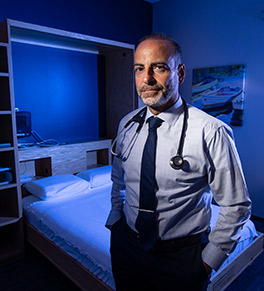
Pacemaker
If you have a slow heartbeat or other type of arrhythmia, a pacemaker can help normalize your heartbeat and help you feel better.
Our approach to pacemakers
If you have a slow heartbeat, other arrhythmias or heart failure, a pacemaker may be an option for you.
A pacemaker is a small device that your electrophysiologist implants under your skin in a minimally invasive procedure. Once in place, your pacemaker can sense when your heart is not beating properly. It then sends electrical signals to normalize your heartbeat.
Our electrophysiology team at UCI Health has extensive experience successfully treating arrhythmias and heart failure with pacemakers.
When you get a pacemaker, the goal is to:
- Reduce your symptoms, such as palpitations, shortness of breath and chest pain
- Improve your heart function
- Improve your quality of life
- Allow you to be more physically activity
After you receive your pacemaker, you’ll continue to see your UCI Health care team for regular follow-ups. They’ll work with you to ensure your pacemaker continues functioning to improve your heart health.
Am I a candidate for a pacemaker?
You may be a good candidate for a pacemaker if you have any of the following:
- An arrhythmia that is difficult to manage
- Atrial fibrillation (AFib)
- A severely slow heartbeat (bradycardia)
- A severely fast heartbeat (tachycardia)
- Heart failure
- Weakened heart muscles due to heart attack, congenital heart disease or a heart transplant
To help determine if a pacemaker is right for you, your UCI Health electrophysiologists will:
- Review your test results, including your EKG, EP study, heart rhythm monitoring and bloodwork
- Discuss your symptoms and how they affect your quality of life
- Evaluate other treatments you’ve already tried
Your doctor will also explain how a pacemaker could help you — and its risks and benefits. They’ll also guide you through what to expect before, during and after the procedure.
Types of pacemakers
A UCI Health, we offer a traditional pacemaker (transvenous pacemaker) or a leadless pacemaker, depending on your specific needs.
Traditional pacemaker
A traditional pacemaker, also known as a transvenous pacemaker, has several parts, including leads (small wires) and a battery pack.
The battery pack is implanted into your upper chest wall. And the leads attach from the battery pack down to your heart muscle.
A traditional pacemaker is used if you need a:
- Single-chamber pacemaker: This device has one lead that attaches to the lower chamber of your heart.
- Dual-chamber pacemaker: This device has two wires: one to the upper chamber of your heart and one to the lower chamber.
Leadless pacemaker
A leadless pacemaker is about 90% smaller than a traditional pacemaker and has no leads. Instead, the device is implanted into your heart lining in the lower chamber of your heart.
A leadless pacemaker can only be used if you need a single-chamber pacemaker. If you need a dual-chamber pacemaker, you’ll have a traditional pacemaker.
A leadless pacemaker may be an option for you if you only need a single-chamber pacemaker, if you do not experience arrhythmia symptoms every day, and/or if you have:
- Bradycardia (slow heart rate)
- Atrial fibrillation (AFib) with bradycardia
- AFib with atrioventricular (AV) block
- Sick sinus syndrome

Schedule a consultation
Meet with one of our cardiologists to find out if a pacemaker is the right treatment for your arrhythmia. Call 714-456-6699, or
Benefits of a pacemaker
Pacemakers normalize your heart rhythm, which helps improve your symptoms, including:
- Fainting
- Shortness of breath
- Fatigue
- Chest pain
This can help you become more active, improve your quality of life and improve your overall heart health.
What to expect with pacemaker surgery
Whether you receive a traditional pacemaker or a leadless pacemaker, you’ll need a minimally invasive procedure to implant the device.
At UCI Health, you’ll have your pacemaker surgery in our cardiac catheterization lab. Your care team will include your electrophysiologist, interventional cardiologist, anesthesiologist and others.
You’ll receive local anesthesia and a sedative to keep you comfortable and asleep throughout the procedure.
Traditional pacemaker procedure
Here’s what you can expect if you receive a traditional pacemaker:
- Your clinicians will make a small incision just below your collarbone.
- They’ll use a blood vessel leading to your heart to insert the leads of the pacemaker into the appropriate chambers of your heart.
- They’ll test the leads to make sure they work correctly.
- They’ll then attach the other end of the lead to a battery pack.
- They’ll finish the procedure by implanting the battery pack under your skin where they made the incision.
- The surgery takes one to two hours.
Leadless pacemaker procedure
Here’s what you can expect if you receive a leadless pacemaker:
- Your clinicians will make a small incision in your groin.
- They’ll use a blood vessel leading to your heart from your groin to move the leadless pacemaker to your heart.
- They’ll attach the pacemaker to the heart lining in the lower chamber of your heart.
- They’ll test the pacemaker to ensure it works correctly.The surgery takes one to three hours.
Recovery after pacemaker surgery
- Here’s what you can expect after both the traditional and leadless pacemaker procedures:
- You’ll spend one to two nights in the hospital for observation and to ensure the pacemaker works well.
- Your care team will program your pacemaker according to your specific needs.
- When you return home, you may be sore at the incision site for several days.
- Your care team will provide you with instructions about easing back into activities like showering, driving and lifting.
- You’ll continue to have regular follow-up appointments with your electrophysiologist.
Why choose UCI Health for a pacemaker?
Leadless pacemaker
One of the biggest advancements in pacemaker technology in recent years is the leadless pacemaker. Leadless pacemakers offer you many benefits, including a shorter recovery time, fewer complications and less activity restrictions. Our UCI Health electrophysiologists strongly advocate this technology and have successfully treated many people with it.
High pacemaker success rates
A pacemaker can normalize your heart rate, helping you manage your arrhythmia and feel better. Our UCI Health clinicians are highly experienced in treating a wide range of arrhythmias and heart failure with pacemakers. We have a 95% success rate for safely implanting pacemakers.
Your partner in care
While a pacemaker can improve your heart function and health, you’ll still need follow-up care. Your electrophysiologist will be your partner in care, ensuring that your pacemaker continues to help you. Our team is dedicated to building a strong relationship with you, centered around communication and compassion. They’ll make sure you understand every aspect of your treatment, and they’ll address any of your concerns or challenges.
Featured Blog Posts

Patient proves it’s never too late for epilepsy surgery

The sleep detectives

First UCI Health LVAD patient gets heart transplant
Just 18 months after Elizabeth Vayssie received a life-saving implant to pump blood through her body, she got the call that every heart-failure patient hopes for: “We have a heart for you.” Vayssie is now the third UCI Health patient kept alive by a left ventricular assist device (LVAD) to survive long enough to undergo a heart transplant.




